The American Bulldog, affectionately known as the American Bully, has been around in the USA in one form or another since the 1800s, brought over with immigrants who settled in the country. It’s often regarded as a modern breed, as it was developed into the breed we recognize in the 1980s and 1990s. It was eventually accepted as a breed in its own right in 2004.
They enjoyed periods of popularity during this time, most recently in the 1980s when the movie Homeward Bound boosted their publicity.
However, there are mixed feelings as to whether this is a good thing or not. Many people have reservations about the American Bulldog and the Bully breed in general, as they have a reputation for aggression and ferocity.
As usual, it’s not the dogs’ fault.
We’ll go into more detail about this later as we investigate the blue variety of this controversial dog breed.
What Is An American Blue Bully?
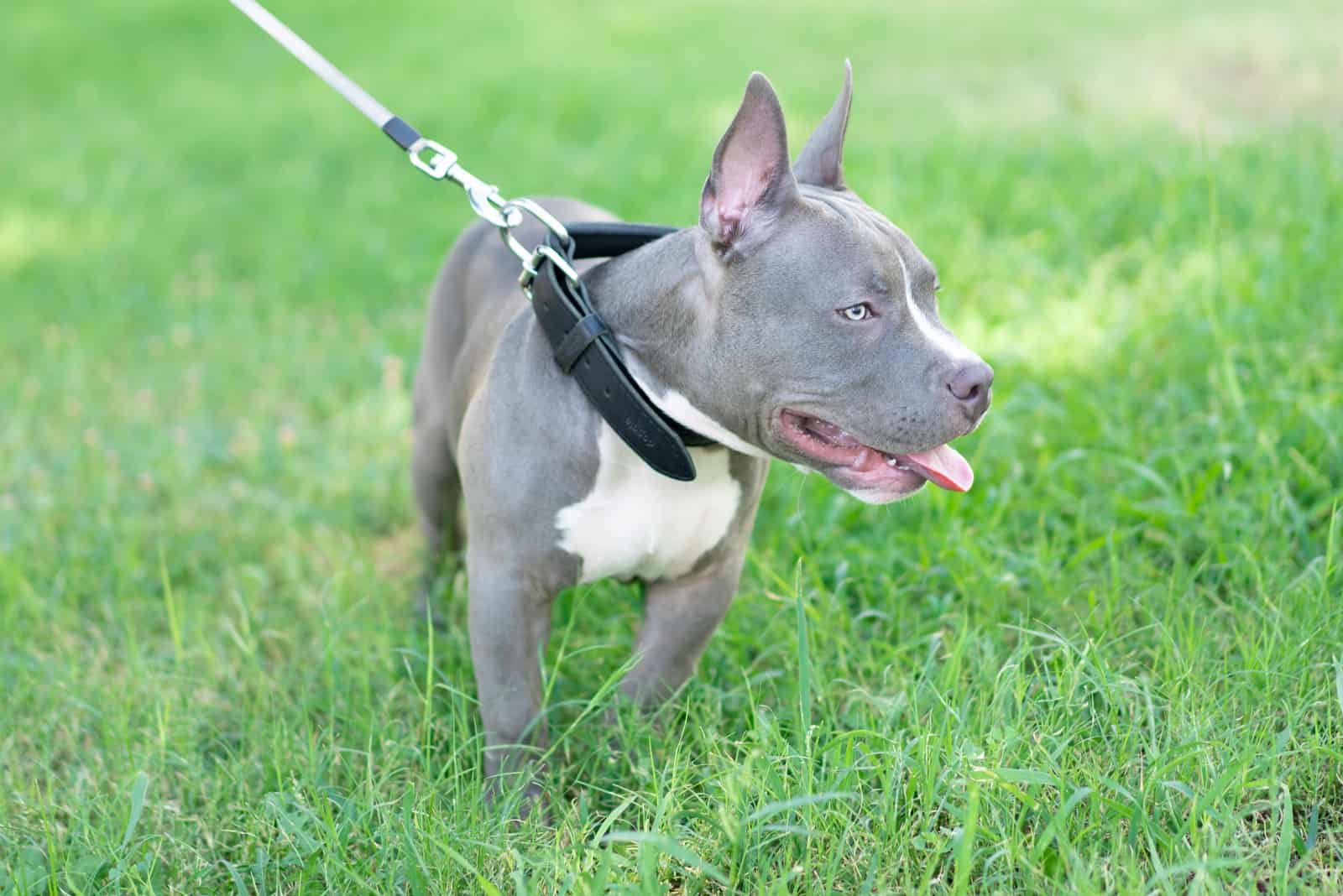
The first thing to say is that it isn’t blue! Sorry if this is a disappointment, but the word blue is a tad misleading. Anyone familiar with the names given to dog coat colors will know that they can be a bit overblown.
Rather than resembling a Smurf on all fours, these dogs will have a beautiful short coat in a shade of silver-gray. This color is produced because the parent dogs both passed on a recessive gene to the pup that gives it a diluted black coat.
So, the American Bully is a hybrid of several breeds, with American Pitbull Terrier as the foundation and the American Staffordshire Terrier and the American Bulldog also contributing.
The blue American Bully is pretty popular, which is understandable, although not everyone is happy about it. There is a school of thought that suggests blue dogs are more prone to skin problems, such as color dilution alopecia (CDA). While this may be true for some breeds, the American Bulldog is not usually included in this group.
The true cause of CDA isn’t known or understood, but the condition is inherited and commonly affects dogs with fawn or blue coats that have been diluted from black, tan, red, or brown.
CDA causes hair loss, recurring skin infections, and dry, itchy skin. There is no cure as it’s an inherited condition. Although it can be managed, this is usually a costly process.
Because of this, some people recommend avoiding blue dogs. However, this ignores the fact that CDA is found in many other diluted colors, as well as that there are no reported cases of CDA in the Weimaraner, an all-blue breed! Also, only 8% of Dobermans are born with a dilute color, but between 50–80% of these have CDA.
The fact is, even if two Blue American Bullies are bred, it doesn’t automatically mean that they will have CDA!
Some people go further and suggest that there are other health risks if a dog has a blue coat, but evidence for this is lacking. It also conveniently forgets that decades of selective breeding has resulted in countless health conditions purely to preserve the breed the way it is.
As with any dog breed, the main thing is to approach a reputable breeder who doesn’t breed purely for color. Ethical breeders strive to produce the healthiest dogs and won’t use color or size as a marketing gimmick.
Is A Blue Bully A Pitbull?
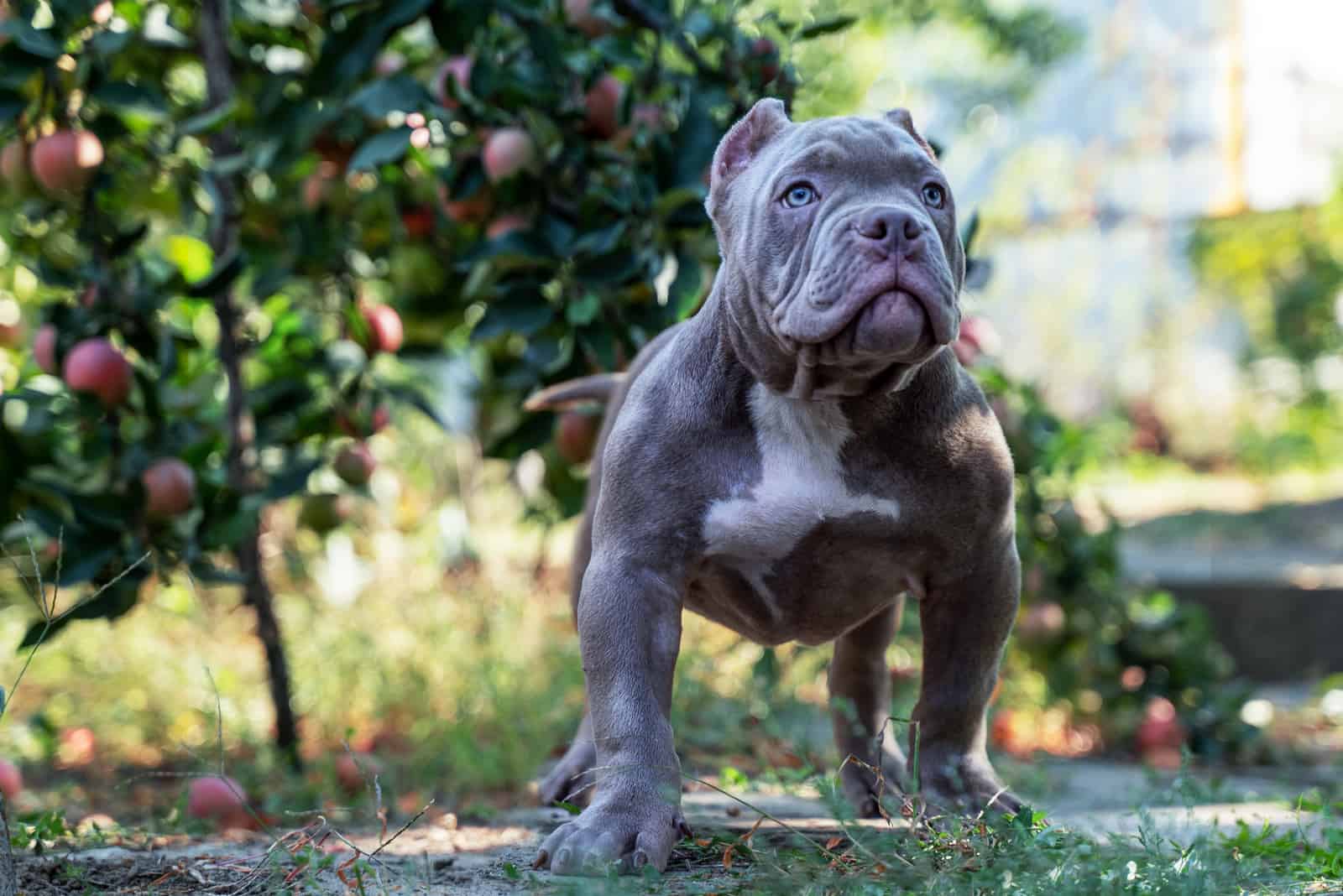
There’s no easy answer to this, as there’s a lot of confusion surrounding the Bully/Pitbull breeds, and feelings tend to run high. One fact that doesn’t help the situation is that it also goes by several other names, including the American Bullypit and the Bully Pitbull!
Even more confusing is that there are several Pitbull breeds, including the American Staffordshire Terrier, American Pitbull Terrier, the Staffordshire Bull Terrier, the American Bulldog, and the American Bully. And when people say Pitbull, they often mean the American Pitbull Terrier!
Stay with us, as we’re not finished yet…
Some people also refer to Bully Breeds, of which the American Bully is one example. These are just dog breeds that are descended from the Bulldog, such as the French Bulldog, Cane Corso, Bull Terrier, and all those mentioned above (and many more besides!).
As the American Bully breed isn’t accepted by most kennel clubs, backyard breeders have taken advantage, experimenting with different breeds to create all kinds of hybrids. Many of these won’t be healthy, and some might be aggressive. It is difficult to judge their temperament without knowing which breeds made them.
The best answer to our question is that the Blue Bully is not a Pitbull, although it is made up of at least three Pitbull breeds, including the American Pitbull Terrier and the American Staffordshire Terrier. Some bloodlines also used the English Bulldog or the Olde English Bulldogge to enhance certain features.
These eventually produced the four sizes accepted by the American Bully Kennel Club (ABKC):
• Pocket Bully– A smaller version, standing between 13 and 17 inches and weighing between 10 and 22 pounds.
• Standard – A muscular and compact medium-sized dog, measuring between 16 and 20 inches at the shoulder and weighing 30 to 65 pounds.
• Classic – Similar in height to the standard, but with less exaggerated features and a lighter frame.
• XL – These bigger dogs stand between 19 and 23 inches at the withers (shoulder) and weigh between 80 and 150 pounds.
With all of these sizes, female dogs are always smaller than males.
There are other classifications, such as the micro and the XXL, but these aren’t accepted by any kennel clubs and have been linked to serious health defects, and in some cases, the larger dogs have been injected with steroids to enhance their muscles.
Find out more on the differences between the XL Bully and XXL Bully.
So, to be as clear as we can, the American Bully is not a Pitbull Terrier, it is a type of Pitbull breed. Much of the concern lies in the fact that the American Pitbull Terrier (APBT) has such a bad reputation. However, even though the American Bully shares its genes and some physical features, breeders and enthusiasts insist that it is nothing like the APBT.
Blue American Bully Puppy
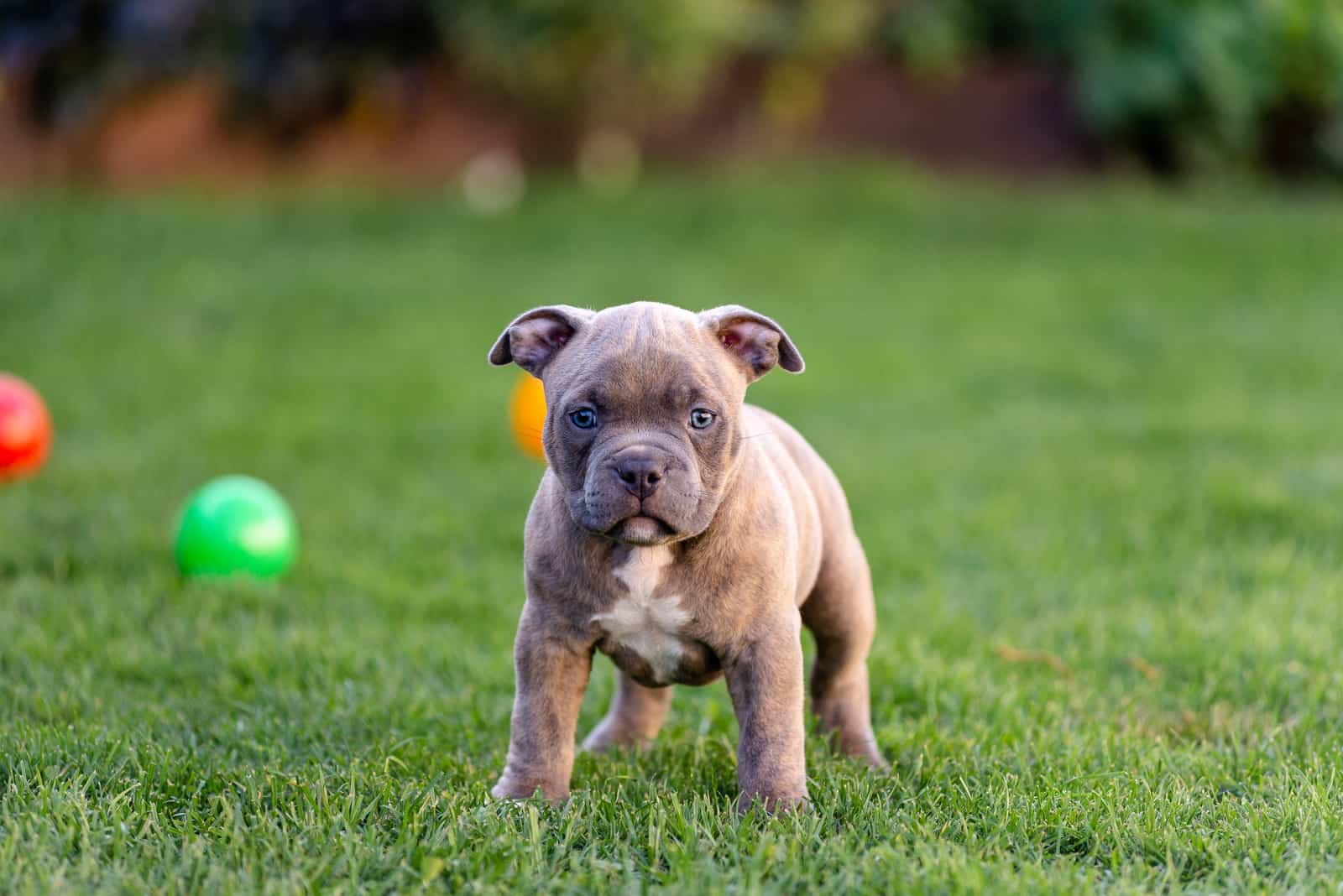
Before getting a puppy of any breed, it is wise to do your homework and see if this is a good match for you, your family, your home, and your circumstances.
And whatever breed you choose, caring for a puppy is a challenge with many potential highs and lows. If you use a reputable breeder, your blue American Bully puppy will be no younger than 7 weeks old and possibly as much as twelve weeks of age.
A good breeder will always match the pup to the family. They will spend time assessing each pup to see whether they are outgoing, mildly confident, or quieter and reserved. After the breeder has met with you, they will gauge which pup is the best fit.
This makes things easier when the pup comes home, but you still have a lot of work to do.
You’ll have to deal with teething, potty training, socialization, obedience training, exercise, and sorting out its food. It’s a lifelong commitment, and your pup will give you unconditional love in return.
You also need to be prepared for the attention that your dog will bring. You may even be questioned as to whether your dog is a Pittie. Some of this attention will be from admiring dog lovers, while others will be concerned that you are keeping a Pitbull breed dog.
If you use a reputable breeder and raise your pup well, then this isn’t a problem either way: it’s always great to have other dog lovers showing an interest in your pooch, and if anyone is wary of your dog, then you can show them what a big softy they really are!
American Blue Nose Bully
Hold on, we were talking about the blue American Bully, and now there’s a blue nose version? What’s that all about?
As with the coat color, your pup’s nose won’t be blue as such. It will probably be black or some shade of gray. Not all blue American Bullies will have blue noses, it’s just a recessive gene that pops up now and again and affects the skin color.
Dog coat colors are created by just two pigments, which are influenced by the genes that the pup inherits from its parents. These genes either dilute or strengthen the colors, telling each hair follicle which color to produce or even to not make any color at all.
One of these pigments also affects skin color, including the color of the dog’s nose. If you chose a dog with a reddish coat, then it might even have a red nose!
However, if you’re now thinking of clowns, you’re barking up the wrong tree…
It’s not that kind of red nose.
On a serious note, it has been suggested that the color of a dogs’ nose and coat can affect its temperament. Some people claim that blue nose bullies (and American Pitbull Terriers) are more aggressive, but there is no evidence to support this. In fact, the opposite seems to be the case, as blue nose Pitbulls are frequently recruited as therapy dogs.
Blue American Bully XL
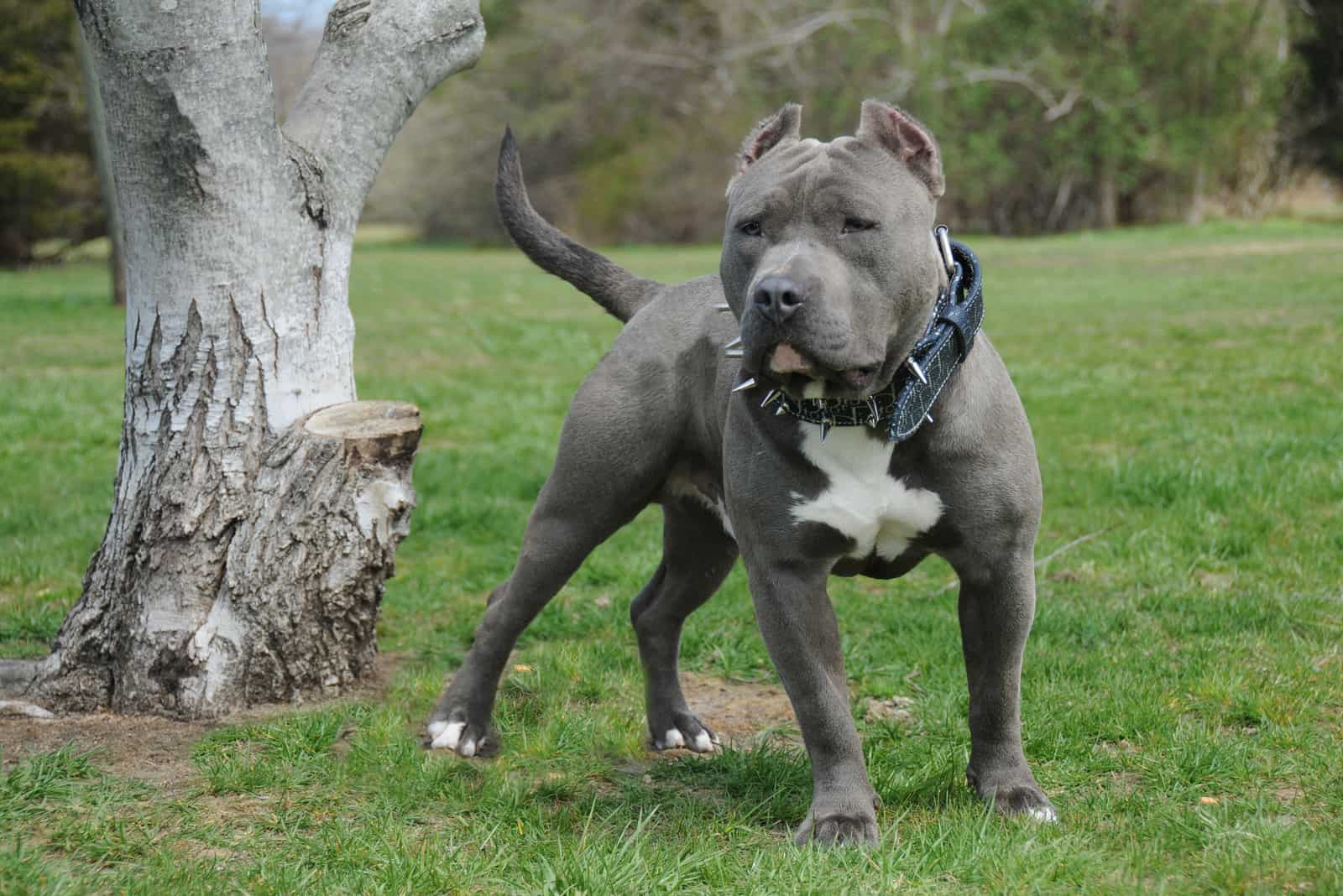
We mentioned the XL American Bully earlier, but now it’s time to look a little closer.
This is a big dog, reaching weights of 150 pounds, sometimes more. It looks a little scary but is nothing less than a gentle giant! They share all the characteristics of the standard American Bully, just in an extra-large size.
Related article: American Bully Growth Chart
If you want a mean-looking dog with a heart of gold, then perhaps the XL Bully is for you. It’s confident, tolerant of strangers, affectionate with family and kids, and doesn’t need a lot of grooming.
This dog is suited to both town and city life, although you must ensure that it gets plenty of exercise to keep its weight in check. You’ll need to commit to a high-quality diet to make sure your dog stays fit and healthy.
Training is essential, as the last thing you want is a 150-pound dog taking off on its own when it feels like it!
Pocket Blue American Bully Puppy
If the XL is too much of a handful, why not go to the other extreme?
The pocket American Bully is a pint-size version with a sweet personality to match. They are still muscular and powerful dogs but nowhere near the XL.
Like the other Bullies, they are great companions and love to spend time with kids, playing in short bursts before slipping off for a nap. Once they’ve recharged their batteries, they’ll be back for more!
They hate being left alone and love nothing more than being with you. You need to watch out for separation anxiety in these pooches as they form intensely strong bonds and will act up if you leave them home alone for long periods.
The Pocket Bully is protective, just like the others, and will always alert you to any threats. Although they are tolerant of strangers (and are even friendly in many cases), they won’t back away from a fight if they feel that you are in danger.
Blue Brindle American Bully
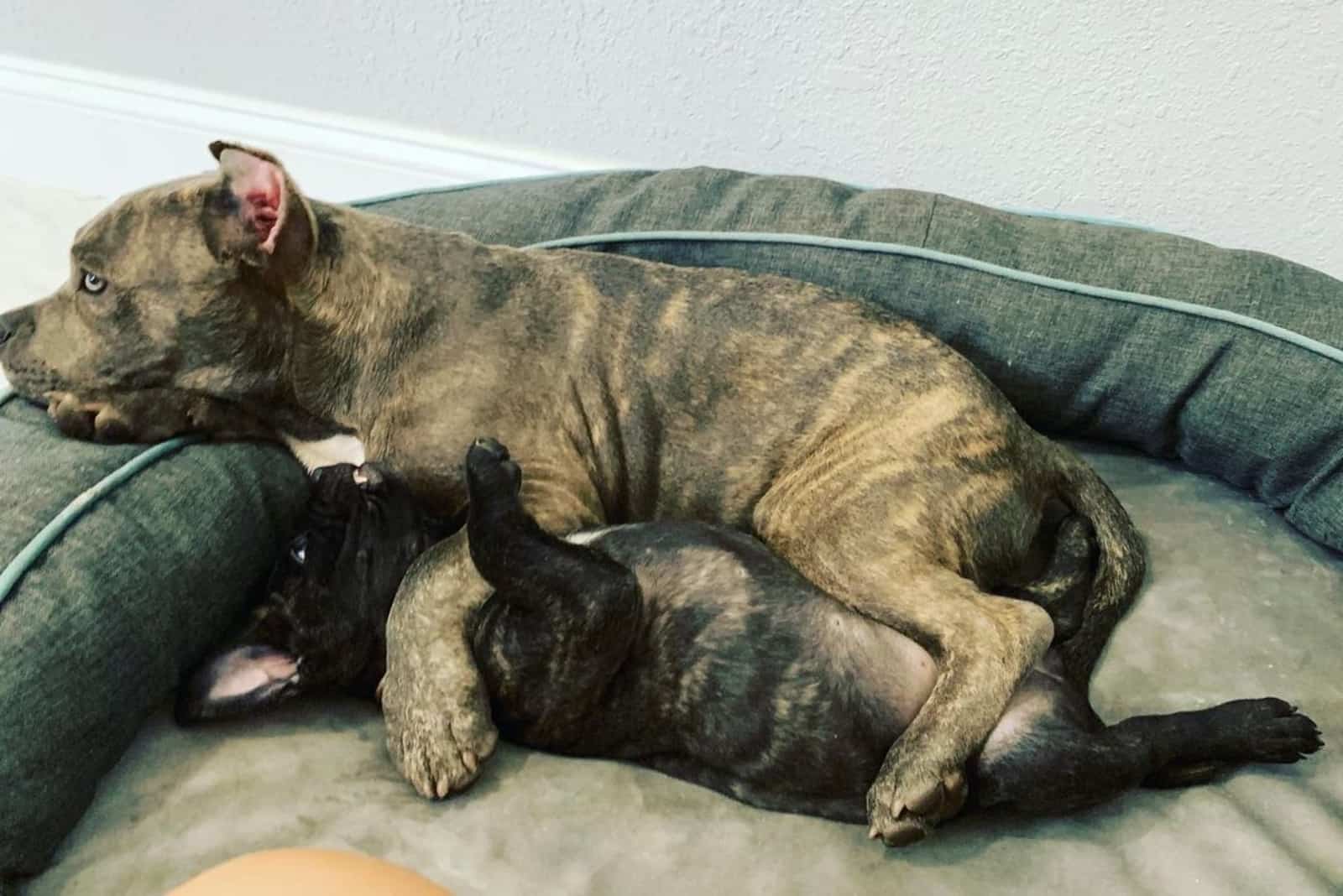
Photo from:@brindletigger
What does blue brindle mean?
Well, blue refers to the coat color (which we have established is a blue-gray), and brindle is a pattern that affects how the coat looks.
Brindle coats aren’t rare in any of the so-called Pitbull or Bully breeds. In fact, many Staffordshire Bull Terriers have a brindle pattern on their brown fur. Brindle patterns exist because the dog’s genes tell the cells in the hair follicles to create a subtle, flecked, ‘tiger stripe’ effect in the coat.
Blue brindle is less common as it’s produced by a recessive gene (both parents have to pass the gene on to the pup for it to have any chance of affecting the coat color), but it isn’t exactly rare.
A blue brindle American Bully will look very distinctive!
If you’re after something that looks even more special, look out for a lilac tri. Again, it isn’t actually purple or lilac – it’s just a way of describing the different colors. This dog is tricolor, meaning that it has three colors, with a dilute blue/chocolate coat and white markings.
Blue Merle American Bully
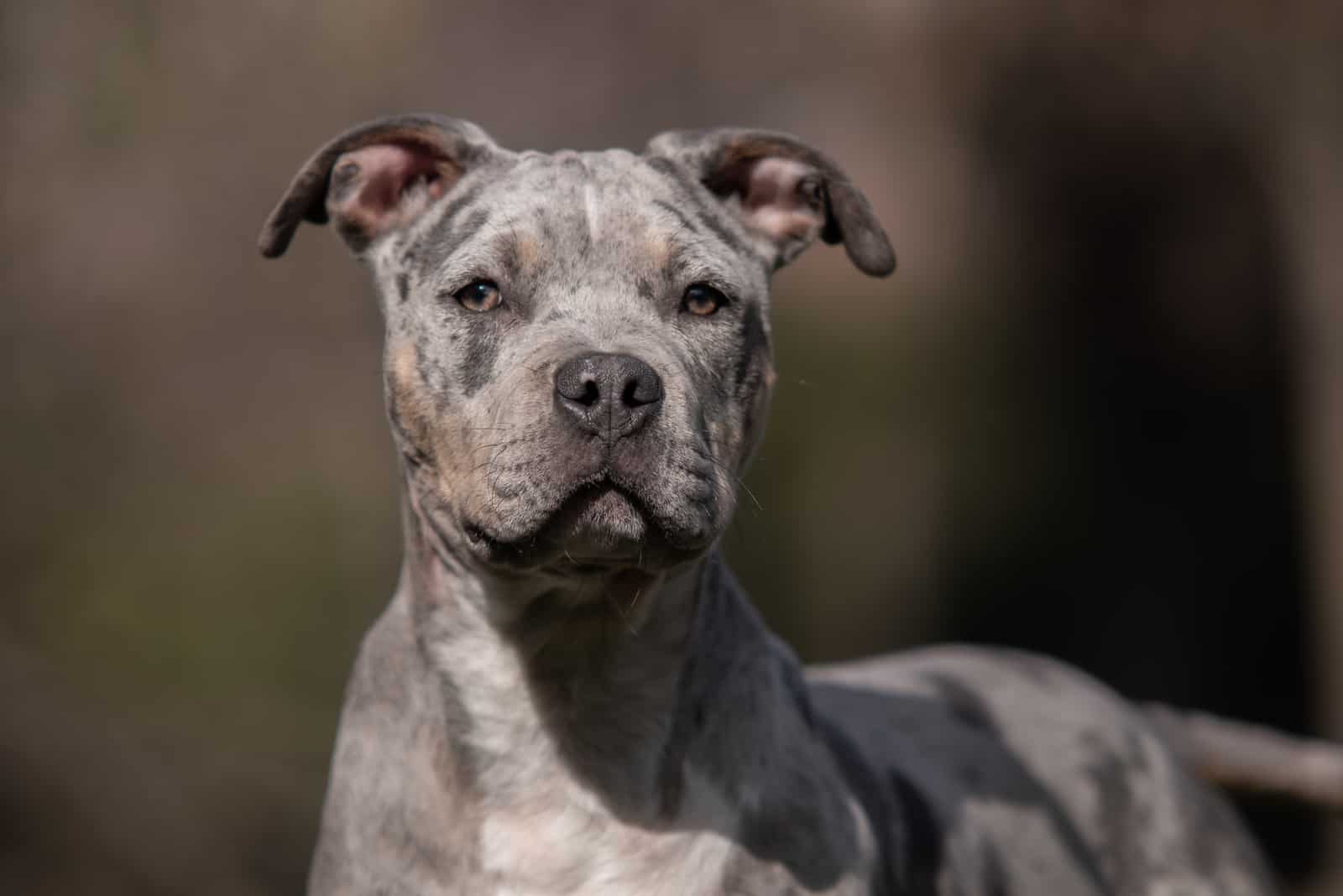
The merle coat is often a subject of debate. Some people love it, others not so much.
Like brindle, merle is a pattern rather than a color, so blue merle refers to random, dark spotting on the coat instead of a solid blue color.
A blue merle American Bully looks amazing, especially when it has blue eyes to match against that mottled gray coat.
Many dog lovers agree, and most merle dogs are unique as you never see the same pattern repeated. However, the gene that causes the merle pattern is also associated with several health issues, such as blindness.
Breeding a merle dog with a non-merle one will produce some pups that are merle and some that aren’t. Breeding two merle dogs will produce all merle pups and some double-merle ones. Many breeders avoid doing this as it is thought to drastically increase the risk of health problems.
The United Kennel Club (UKC) states in the breed standards that any color, color pattern, or combination of colors is acceptable, except for merle.
Even so, others insist that the risk to merle dogs is low and that they are generally as healthy as any other.
The trick is to do your research before buying and find a reputable breeder.
See Also: Merle American Bully: What Are They & Why Are They Special?
Blue American Bully With Ears
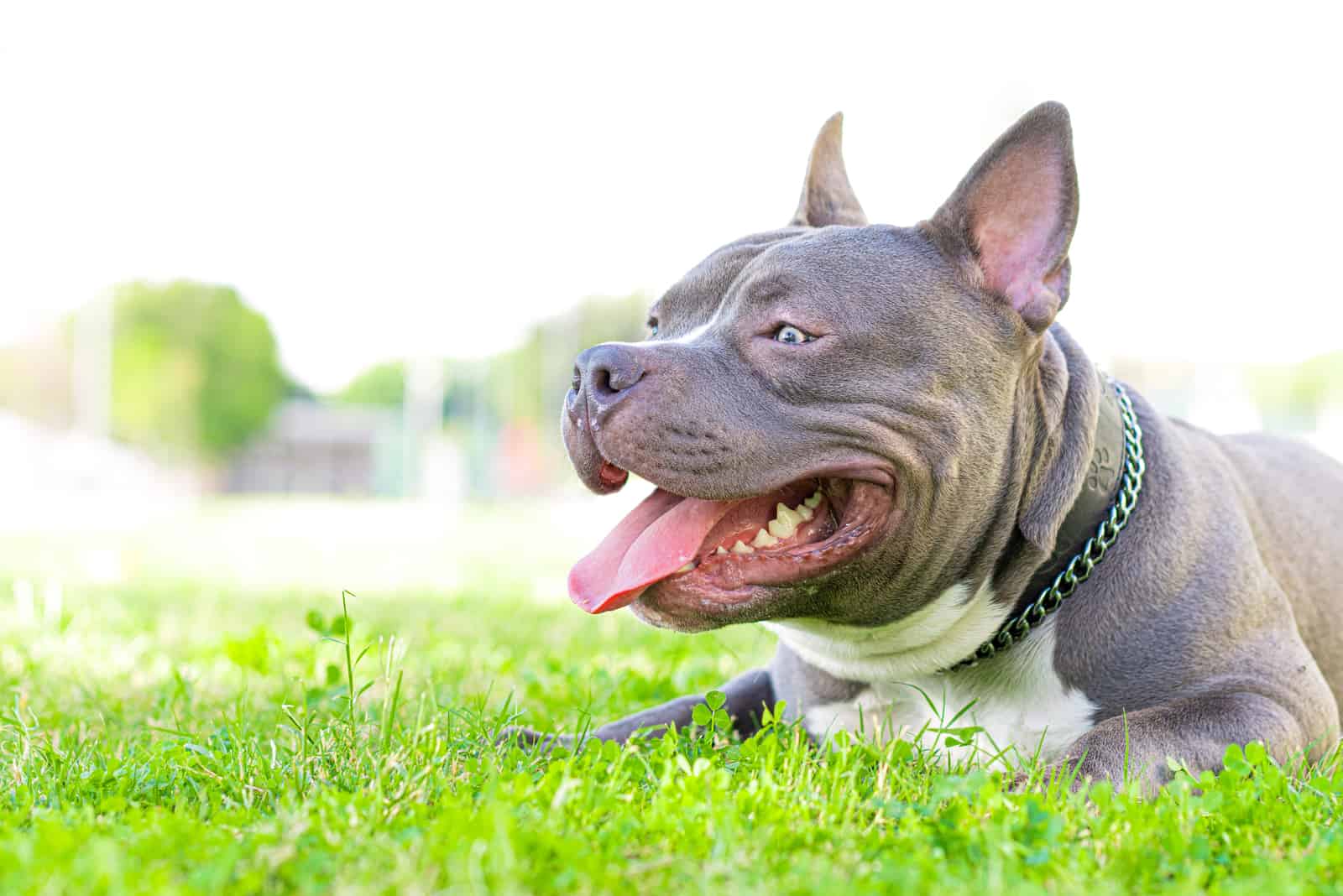
Now, you might be thinking, surely all dogs have ears?
And you’d be right, of course.
But over the years, it has become traditional to crop the ears of certain breeds. In the past, this was done to reduce the chance of injury while the dog was fighting or hunting. These days, it’s done purely for cosmetic reasons, encouraged by organizations like the AKC because their breed standards stipulate that ears should be cropped for conformation. Dogs with natural ears will be disqualified from shows or will lose marks.
So, you can get a Blue American Bully with ears, just as nature intended, but you’ll have to find a breeder who agrees to leave the ears intact.
The cropping process usually takes place well before the pup is 12 weeks old, as the cartilage starts to harden after this point, and the surgery may not be successful. Surgery should always be performed under anesthesia, but this often doesn’t happen, and no pain relief is given in many cases.
The sore and bleeding ear stumps are sometimes strapped to splints to give them a distinctive shape, adding to their discomfort. All this is done for the sake of conforming to breed standards and because people like the way it looks.
Advocates of ear cropping argue that it reduces the risk of ear infections and improves the dog’s hearing. It’s important to note that there is no scientific basis for these arguments. It’s more likely that they simply prefer the sharp-eared look, which only adds to the dogs’ intimidating appearance and reputation for being aggressive.
Dogs’ ears are an important part of their communication mechanism. Ear cropping robs them of this ability, leading to misunderstanding, frustration, and aggression, in some cases.
Ear cropping has been banned in the UK, most of Europe, New Zealand, Australia, and nearly all of Canada. This is in line with animal welfare laws that recognize this as a purely cosmetic procedure that causes unnecessary pain and suffering.
America lags behind, still allowing the practice. Nine states regulate ear cropping, stating that it must only be undertaken by a licensed veterinarian.
We can only hope that this situation soon changes for the sake of millions of pups everywhere.
You can read more information on this topic in our article on Bully ear cropping.
How Much Are American Bully Puppies?

You can pick up an American Bully Puppy for between $500 and $800, although you might want to think twice before doing so if you want a show-quality dog. At these prices, your pup will probably not be purebred and will be of a lesser bloodline. And there’s a good chance that it will come with a bunch of health problems if you don’t use a good breeder!
If you’re serious about getting a blue American Bully, be prepared to set aside at least $2,000 and possibly as much as $5,000. These are the prices you should expect to pay if you approach a reputable, ethical American Bully breeder. If you’re planning to raise the next ABKC champion, then be prepared to pay at least this amount.
The size of your dog when it’s full-grown will also have a bearing on the price. Here are some examples of the average price for each different size:
• Pocket size $2,000
• Standard/Classic $2,500
• XL $3,000
Bear in mind that this is a rough guide and that prices will vary by region and that breeders will charge more for highly-prized bloodlines such as the Gottiline.
Also, American Bully mixes might not cost the same as purebret doggies.
Are American Bully Dogs Dangerous?
The short answer is no!
This question takes us back to the issue of its links to the Pitbull dog, which people usually associate with aggression. Many Pitbull breed enthusiasts agree that this reputation is unfair and relates only to a handful of poorly-bred animals. This only highlights the need for stricter controls on dog breeding and stronger laws to tackle dogfighting.
Part of the problem is that most Pitbull breeds were originally produced for the gruesome pastime of bull-baiting. They had to be strong, muscular, powerful, and vicious if they were to survive the bull pit. And when this ‘sport’ was outlawed, people adapted the dogs for fighting each other.
Happily, this has changed over the years, and dogfighting is no longer a mainstream event (though some despicable individuals still engage in this vile practice).
Another issue might be the name bully. Most people will associate this word with a mean kid that made your life a misery at school, or maybe an unpleasant character in the office that made going to work a living hell. Well, this dog isn’t anything like that! Bully is just short for Bulldog or Pitbull.
American Bullies were purposely bred as ideal family and companion dogs. Any signs of aggression are uncharacteristic and undesirable!
Ordinarily, the American Bully is placid, friendly, playful, and affectionate, despite its powerful, muscular body and sometimes fearful looks. They are intelligent and eager to please, so training is usually fairly straightforward.
Of course, any dog can be aggressive if they are neglected, abused, in pain, or afraid. Smart, active dogs that aren’t given enough exercise and mental stimulation can also become aggressive out of frustration.
If you do buy a blue American Bully, only buy from a reputable breeder and ask to meet the parent dogs. Observe them to see how they act around the breeder. Watch for any aggression or wariness, as this could indicate what your pup will be like. If they seem happy and playful, then your pup is likely to have a similar temperament.
Finally, if the breeder refuses to let you see the parents, walk away!
Final Thoughts
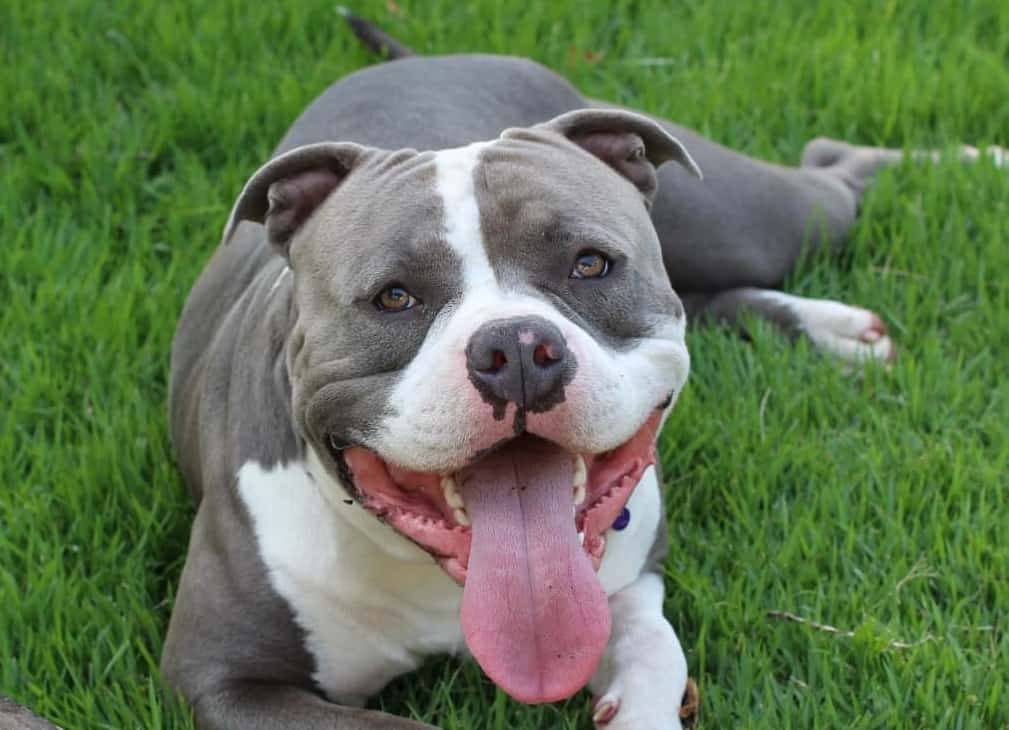
Photo from: @blue_american.bully
So, it’s not blue, it isn’t a Pitbull, but it is classed as part of the Pitbull family, as well as a member of the Bully breeds.
Is that all settled? Good!
Seriously though, the blue American Bully is a wonderful dog. They make excellent family pets and will be a loyal companion for life.
Although debate continues about blue dogs and the merle pattern, evidence is often sketchy and incomplete. To be fair, there’s also a lot of prejudice about certain coat colors, which is why many enthusiasts rage against them. It isn’t about health – it’s about keeping a breed looking a particular way.
Still interested in a blue American Bully? Well, good for you! As long as you choose your breeder wisely, then there’s nothing stopping you. Except that predicting the color of the pups isn’t easy! No ethical breeder will aim to produce a particular color as this leads to an even more limited gene pool. So, you might have to wait or shop around. A good breeder will always refer you to another if they don’t have what you want.
You should take note that even though you might pay upwards of $3,000, you won’t be able to enter your prize pooch in American Kennel Club shows. You may enter it into United Kennel Club dog shows, but you’ll need to check the breed standards first.
However, if you just want a loyal companion who’ll stick by your side, show you much love and affection, play happily for hours with your kids, watch your back, all the while looking like an armored tank, then there’s no need to splash out for a show-quality blue American Bully.
The choice is yours!
Read Next: Top 9 Pocket Bully Breeders: PupVine’s Finest Picks!















